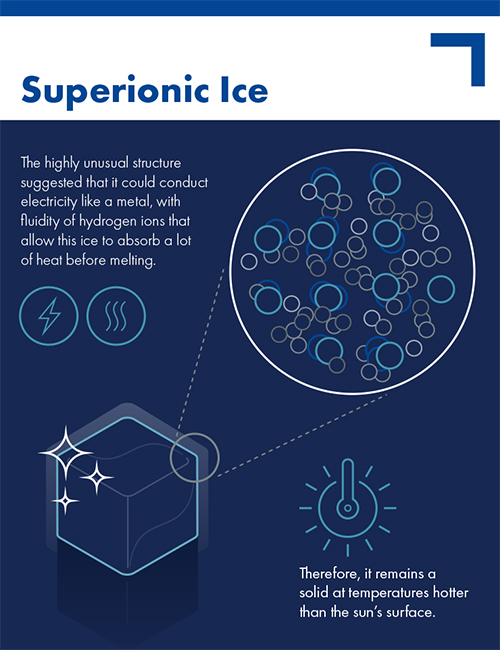
It can be hard to imagine what happens to common molecules under the extreme conditions on other planets. For example, Earthlings know water as an essential ingredient for life that exists as a solid, liquid and gas. However, scientists examining how water behaves under different conditions have identified about 20 different types of ice. The most recent addition to this list is “superionic ice,” which is thought to be the main form of ice on water-rich planets like Uranus and Neptune...
In 2019, scientists were finally able to create the extreme temperatures and pressures required to produce this type of ice in a laboratory and published the results in Nature [Physics]. The technique involved blasting a water droplet with a high-pressure shock wave, raising the pressure to 100-400 gigapascals and the temperature to 2,000-3,000 Kelvin. For comparison, the center of the Earth has a pressure of 360 gigapascals, and the surface of the Sun has a temperature of 5,778 Kelvin.
Superionic ice formed under these experimental conditions but only lasted for about 20 nanoseconds (20 billionths of a second). That was enough time to use X-ray diffraction to confirm the predicted structure of the oxygen lattice, and a few additional features.
In November 2021, a different research group developed a more reliable method for producing this new form of ice, as Nature Physics reports. They squeezed a water droplet between two diamonds and then blasted it with powerful lasers to achieve temperatures and pressures similar to what exists at the center of the Earth. This method produced ice that lasted for microseconds (millionths of a second) instead of just nanoseconds (billionths of a second), allowing it to be studied in more detail.
MORE from "Northrop Grumman NOW" © 2022 Northrop Grumman Corporation. All rights reserved.
See also the APS highlight: "How Do Ice Giants Maintain Their Magnetic Fields?"
Journal article: Vitali B. Prakapenka1*, Nicholas Holtgrewe1,2, Sergey S. Lobanov2, 3, and Alexander F. Goncharov2**, “Structure and properties of two superionic ice phases,” Nat. Phys., published on line 14 October 2021. DOI: 10.1038/s41567-021-01351-8
Author affiliations: 1TheUniversity of Chicago, 2Carnegie Institution of Washington, 3GFZ German Research Center for Geosciences
Correspondence: * [email protected], ** [email protected]
The Advanced Photon Source is a DOE Office of Science User Facility operated for the DOE Office of Science by Argonne National Laboratory under Contract No. DE-AC02-06CH11357
The U.S. Department of Energy's APS at Argonne National Laboratory is one of the world’s most productive x-ray light source facilities. Each year, the APS provides high-brightness x-ray beams to a diverse community of more than 5,000 researchers in materials science, chemistry, condensed matter physics, the life and environmental sciences, and applied research. Researchers using the APS produce over 2,000 publications each year detailing impactful discoveries, and solve more vital biological protein structures than users of any other x-ray light source research facility. APS x-rays are ideally suited for explorations of materials and biological structures; elemental distribution; chemical, magnetic, electronic states; and a wide range of technologically important engineering systems from batteries to fuel injector sprays, all of which are the foundations of our nation’s economic, technological, and physical well-being.
Argonne National Laboratory seeks solutions to pressing national problems in science and technology. The nation's first national laboratory, Argonne conducts leading-edge basic and applied scientific research in virtually every scientific discipline. Argonne researchers work closely with researchers from hundreds of companies, universities, and federal, state and municipal agencies to help them solve their specific problems, advance America's scientific leadership and prepare the nation for a better future. With employees from more than 60 nations, Argonne is managed by UChicago Argonne, LLC, for the U.S. DOE Office of Science.
The U.S. Department of Energy's Office of Science is the single largest supporter of basic research in the physical sciences in the United States and is working to address some of the most pressing challenges of our time. For more information, visit the Office of Science website.
